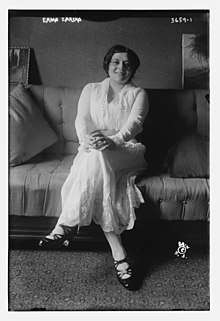Erma Zarska
Erma Zarska (June 9, 1889 – March 30, 1971), also seen as Erma Zareska, Heřmy Žárskej or Heřma Žárská, was a soprano with the Metropolitan Opera in the 1915–1916 season. She also sang with the Prague National Theatre and the Slovak National Theatre.
Erma Zarska | |
|---|---|
 Erma Zarska, from the Bain News Service collection, Library of Congress. | |
| Born | Hermina Maria Žárská June 9, 1889 Olomouc, Moravia |
| Died | March 30, 1971 Prague |
| Nationality | Czech |
| Other names | Heřmy Žárskej, Erma Zareska, Herma Žárská |
| Occupation | Opera singer |
Early life
Hermína Maria Žárská was born in Olomouc, the daughter of Ignác Žárský, a blacksmith and carriage builder.[1] She trained as a singer in Prague and Berlin.[2]
Career
Zarska sang at the Prague National Theatre as a young woman,[3][4] in Hubička, Dalibor, and The Bartered Bride, all operas by Smetana.[2] She made her debut with the Metropolitan Opera in New York in November 1915;[5][6] however, "a severe cold" affected her voice, and it failed during her debut performance in Lohengrin. "At the end she was singing almost in a whisper," according to the New York Times reviewer.[7] Emmy Destinn returned to the Met to take over the role while Zarska recovered.[8]
Zarska also sang the role of Santuzza in the Met's production of Cavalleria Rusticana in February 1916, with Sophie Breslau singing another part.[9][10] During the run of Rusticana, she had a further embarrassment on stage, when her daring gown's shoulder strap slipped and "the audience saw a great deal of Erma", according to reports.[11] She returned to Europe at the end of that season, when her contract was not renewed.[12]
She made recordings for Columbia in 1916.[13][14] She was a soloist with the Slovak National Theatre in the 1921–1922 season.[2]
Personal life
Zarska died in Prague in 1971, aged 80 years.[2]
References
- "Ignác Žárský – Historické kočáry" (in Czech). Retrieved 2020-05-13.
- "Heřma Žárska, dramatická sopranistka s farebným sopránom a osobným čarom". Opera Slovakia (in Slovak). 2019-06-09. Retrieved 2020-05-13.
- "Two Opera Singers Arrive". The New York Times. 1915-10-18. p. 9. Retrieved 2020-05-13 – via Newspapers.com.
- "Name Like Roll of Drum". The Wilkes-Barre Record. 1915-11-12. p. 7. Retrieved 2020-05-13 – via Newspapers.com.
- "Season of Grand Opera Opens at the Metropolitan". The Theatre. 22: 284–285. December 1915.
- "New Members of the Metropolitan Opera". Opera Magazine. 2: 15. November 1915.
- "New Singer's Voice Fails at her Debut". The New York Times. 1915-11-27. p. 15. Retrieved 2020-05-12 – via Newspapers.com.
- "Metropolitan Opera House". The Brooklyn Daily Eagle. 1915-12-21. p. 6. Retrieved 2020-05-13 – via Newspapers.com.
- Fitzgerald, Gerald (2016-06-11). Annals of the Metropolitan Opera: The Complete Chronicle of Performances and Artists. Springer. p. 243. ISBN 978-1-349-11976-9.
- "Erma Zarska Reappears". The New York Times. 1916-02-03. p. 7. Retrieved 2020-05-13 – via Newspapers.com.
- "Her Suspender Slipped". The Washington Herald. 1916-02-15. p. 3. Retrieved 2020-05-13 – via Newspapers.com.
- "More French Song in Coming Opera". The Sun. 1916-05-23. p. 9. Retrieved 2020-05-13 – via Newspapers.com.
- Downes, Olin (1918). The Lure of Music: Depicting the Human Side of Great Composers, with Stories of Their Inspired Creations. Harper & Brothers. p. 300.
- "Record Bulletins for September 1916" (PDF). The Talking Machine World. 12: 100. August 15, 1916.